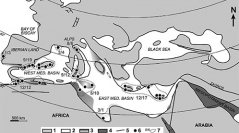

 Comptes Rendus Palevol
12 (5) - Pages 245-255
Comptes Rendus Palevol
12 (5) - Pages 245-255The Late Miocene distribution and diversity of zooxanthellate-like corals in the Mediterranean are analyzed in their paleobiogeographical framework, using our REEFCORAL database. The Late Miocene Mediterranean pool reached 20 z-coral genera. Although this fauna could build flourishing reef ecosystems during the Early Messinian, it was a relict fauna with severely limited speciation that lived on the edge of its ecological requirements in terms of solar energy and temperature range. Most z-coral genera, because they had long stratigraphic ranges and had survived previous extinctions, were able to adapt to the Messinian environments, which were unusual for such biotas. Hence, Porites, the most widespread genus in the region and also the most dominant in ecological assemblages, was the best equipped to cope with the drastic changes related to the Messinian Salinity Crisis.
Late Miocene, Mediterranean, Corals, Biodiversity, Messinian, Tortonian, Salinity Crisis